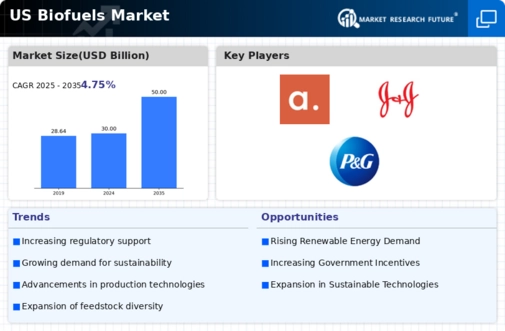Rising Energy Prices
The bio fuels market is experiencing a notable surge in interest due to rising energy prices. As fossil fuel costs escalate, consumers and businesses are increasingly seeking alternative energy sources. This shift is likely to drive demand for bio fuels, which are often perceived as more stable and sustainable options. In 2025, the average price of crude oil is projected to remain above $80 per barrel, prompting a reevaluation of energy strategies across various sectors. Consequently, the bio fuels market stands to benefit from this trend, as it offers a viable solution to mitigate the impact of fluctuating energy costs. Furthermore, the increasing volatility in traditional energy markets may lead to a more significant investment in bio fuels, enhancing its market share and attractiveness to investors.
Government Mandates and Policies
The bio fuels market is significantly influenced by government mandates and policies aimed at reducing greenhouse gas emissions. In the US, the Renewable Fuel Standard (RFS) mandates a specific volume of renewable fuels to be blended into the transportation fuel supply. As of 2025, the RFS requires approximately 20 billion gallons of renewable fuels, which includes bio fuels, to be blended annually. This regulatory framework not only supports the growth of the bio fuels market but also encourages innovation and investment in renewable technologies. Additionally, state-level initiatives further bolster this trend, with various states implementing their own renewable fuel mandates. Such policies create a favorable environment for bio fuels, ensuring a steady demand and promoting long-term sustainability in the energy sector.
Technological Innovations in Production
Technological innovations are playing a crucial role in shaping the bio fuels market. Advances in production techniques, such as improved fermentation processes and genetic engineering of feedstocks, are enhancing the efficiency and cost-effectiveness of bio fuel production. For instance, the development of second-generation bio fuels, which utilize non-food feedstocks, is gaining traction. This innovation not only addresses food security concerns but also expands the potential feedstock base for bio fuels. As of 2025, the production capacity for advanced bio fuels is expected to increase by approximately 15%, driven by these technological advancements. Such innovations are likely to make bio fuels more competitive with traditional fossil fuels, thereby increasing their market share and appeal to consumers and businesses alike.
Investment in Infrastructure Development
Investment in infrastructure development is a critical driver for the bio fuels market. As the demand for bio fuels increases, there is a corresponding need for enhanced infrastructure to support production, distribution, and consumption. In 2025, it is projected that investments in bio fuel infrastructure will exceed $5 billion, focusing on the construction of new production facilities and the expansion of distribution networks. This influx of capital is likely to facilitate greater accessibility to bio fuels, making them more competitive with traditional fuels. Moreover, improved infrastructure can lead to economies of scale, reducing production costs and ultimately benefiting consumers. As such, the bio fuels market stands to gain significantly from these infrastructure investments, positioning itself for sustained growth in the coming years.
Environmental Awareness and Corporate Responsibility
The bio fuels market is benefiting from a growing awareness of environmental issues among consumers and corporations. As climate change becomes an increasingly pressing concern, many companies are adopting sustainable practices and seeking to reduce their carbon footprints. This shift is leading to a heightened demand for bio fuels, which are often viewed as a cleaner alternative to conventional fossil fuels. In 2025, it is estimated that over 60% of consumers in the US prioritize sustainability in their purchasing decisions, influencing corporate strategies. Consequently, businesses are more likely to invest in bio fuels to align with consumer expectations and enhance their corporate social responsibility profiles. This trend not only supports the bio fuels market but also fosters a broader transition towards sustainable energy solutions.

















Leave a Comment